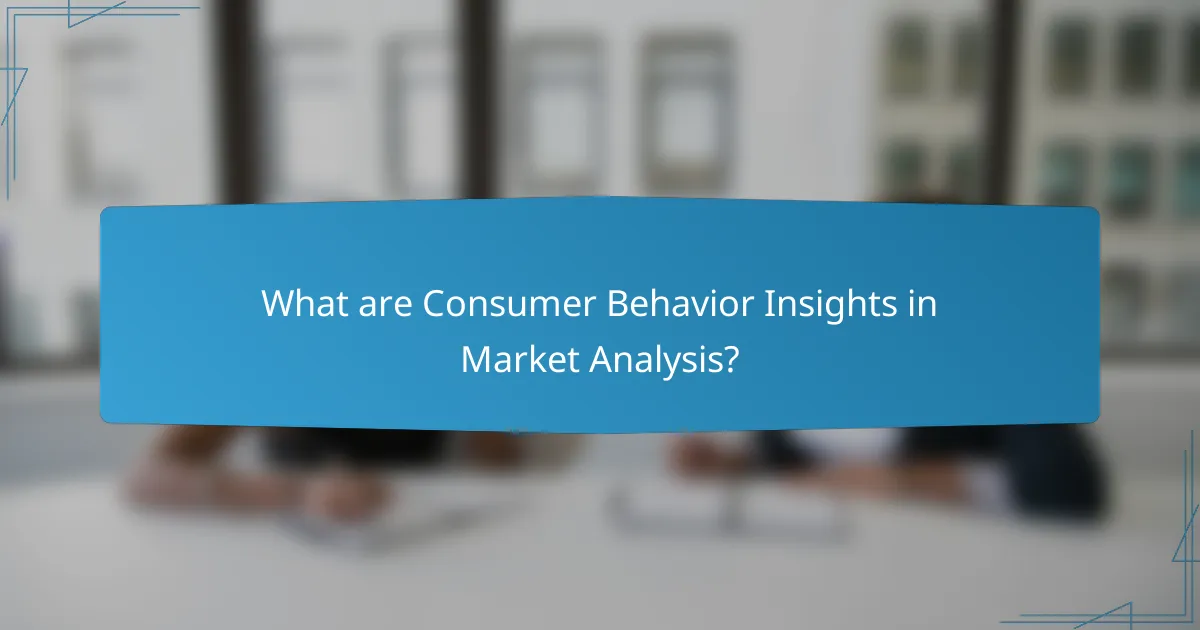Consumer behavior insights in market analysis focus on understanding how consumers make purchasing decisions, influenced by factors such as demographics, psychographics, and cultural influences. Key psychological factors, including motivation, perception, beliefs, attitudes, and learning, play a crucial role in shaping consumer preferences and choices. Research indicates that a significant percentage of consumers are willing to pay more for sustainable brands, highlighting the importance of aligning products with consumer values. By analyzing purchasing patterns and leveraging real-time data from online behavior, businesses can optimize their marketing strategies, enhance customer satisfaction, and gain a competitive advantage. This article delves into the psychological factors affecting consumer behavior and their economic impact on market analysis.

What are Consumer Behavior Insights in Market Analysis?
Consumer behavior insights in market analysis refer to the understanding of how consumers make purchasing decisions. These insights are derived from analyzing consumer preferences, motivations, and buying patterns. Market analysts study factors such as demographics, psychographics, and cultural influences. This analysis helps businesses tailor their marketing strategies effectively. For example, a study by Nielsen found that 66% of consumers are willing to pay more for sustainable brands. Such statistics underscore the importance of aligning products with consumer values. Understanding these insights allows companies to predict trends and improve customer satisfaction.
How do psychological factors influence consumer behavior?
Psychological factors significantly influence consumer behavior by shaping perceptions and decision-making processes. These factors include motivation, perception, beliefs, attitudes, and learning. Motivation drives consumers to fulfill their needs and desires, affecting their purchasing choices. Perception influences how consumers interpret marketing messages and product attributes. Beliefs and attitudes shape preferences and can lead to brand loyalty. Learning from past experiences impacts future buying behavior. Research shows that 70% of purchasing decisions are made subconsciously, highlighting the power of psychological influences in consumer behavior.
What role does perception play in consumer decision-making?
Perception significantly influences consumer decision-making. It shapes how consumers interpret information about products. Consumers form attitudes based on their perceptions of brand image and quality. Positive perceptions can lead to increased trust and loyalty. Conversely, negative perceptions may deter purchases. Research shows that 70% of buying experiences are based on how customers feel they are being treated. This indicates that perception can directly impact sales and market performance. Therefore, understanding consumer perception is crucial for effective marketing strategies.
How do emotions affect purchasing choices?
Emotions significantly influence purchasing choices. Positive emotions can enhance the likelihood of buying. For example, happiness may lead to impulsive purchases. Negative emotions, such as anxiety, can lead to avoidance of certain products. Research shows that emotional responses can trigger memory recall related to brands. This recall can affect brand loyalty and preference. A study by the Journal of Consumer Research found that emotional advertising increases purchase intentions. Consumers often associate products with the feelings they evoke. Thus, emotions play a crucial role in shaping consumer behavior.
What economic impacts arise from consumer behavior?
Consumer behavior significantly influences economic impacts. It drives demand for goods and services. Increased demand can lead to higher production rates. This, in turn, stimulates economic growth. Consumer preferences also affect pricing strategies. Businesses adjust prices based on perceived value. Furthermore, consumer behavior can influence market competition. Companies innovate to meet changing consumer needs. According to the Bureau of Economic Analysis, consumer spending accounts for over 68% of GDP in the United States. This statistic highlights the critical role of consumer behavior in shaping the economy.
How does consumer spending influence market trends?
Consumer spending significantly influences market trends by dictating demand for goods and services. When consumers increase their spending, businesses respond by adjusting their offerings. This can lead to the introduction of new products or enhancements to existing ones. Conversely, a decrease in consumer spending can result in reduced production and layoffs. Historical data shows that during economic expansions, consumer spending rises, leading to a booming market. For instance, in 2021, U.S. consumer spending increased by 11.8%, contributing to economic recovery post-pandemic. This trend illustrates how consumer behavior directly correlates with market dynamics.
What are the effects of consumer confidence on the economy?
Consumer confidence significantly impacts the economy. Higher consumer confidence leads to increased spending. When consumers feel optimistic, they are more likely to make purchases. This boost in spending stimulates economic growth. Conversely, low consumer confidence results in reduced spending. This decline can lead to slower economic growth or recession. According to the University of Michigan’s Consumer Sentiment Index, consumer confidence directly correlates with consumer spending trends. Historical data shows that during economic downturns, consumer confidence drops, leading to decreased retail sales. Thus, consumer confidence acts as a critical indicator of economic health.

What are the key psychological factors affecting consumer behavior?
Key psychological factors affecting consumer behavior include motivation, perception, beliefs, attitudes, and learning. Motivation drives consumers to fulfill needs and desires. For example, Maslow’s Hierarchy of Needs illustrates how basic needs influence purchasing decisions. Perception shapes how consumers interpret marketing messages and product information. Studies show that consumers perceive value based on brand reputation and quality. Beliefs and attitudes influence preferences and choices. Research indicates that positive brand attitudes lead to increased loyalty. Learning, through past experiences and information, affects future buying behavior. For instance, consumers often rely on previous purchases to guide new decisions. Understanding these factors helps marketers tailor strategies effectively.
How does motivation drive consumer purchasing decisions?
Motivation significantly influences consumer purchasing decisions. It drives individuals to fulfill needs and desires, guiding their choices in the marketplace. For instance, Maslow’s Hierarchy of Needs illustrates how basic needs motivate purchases. Consumers seek products that satisfy physiological needs, safety, social belonging, esteem, and self-actualization. Research shows that emotional motivations, such as the desire for status, can lead to brand loyalty. A study by the Journal of Consumer Research found that consumers are more likely to purchase products that align with their personal values and aspirations. This demonstrates that motivation shapes not only the decision-making process but also brand perception and loyalty.
What types of needs do consumers seek to satisfy?
Consumers seek to satisfy various types of needs, including physiological, safety, social, esteem, and self-actualization needs. Physiological needs encompass basic survival requirements like food, water, and shelter. Safety needs involve security and protection from physical and emotional harm. Social needs pertain to belongingness and love, including relationships and community connections. Esteem needs relate to self-esteem and recognition from others, fostering feelings of accomplishment. Self-actualization needs focus on personal growth and achieving one’s full potential. These categories are based on Maslow’s Hierarchy of Needs, a widely recognized psychological theory that illustrates human motivation.
How do cultural influences shape consumer motivations?
Cultural influences significantly shape consumer motivations by affecting values, beliefs, and behaviors. These factors dictate what consumers consider important and desirable. For example, collectivist cultures prioritize family and community, leading to motivations centered around group benefits. In contrast, individualistic cultures emphasize personal achievement, driving motivations for self-expression and personal gain.
Research by Hofstede indicates that cultural dimensions, such as individualism versus collectivism, directly impact purchasing decisions. Consumers from collectivist societies often prefer brands that promote social harmony. Conversely, those from individualistic cultures may favor brands that highlight personal success.
Furthermore, cultural rituals and traditions can create specific consumer needs. For instance, holidays and festivals often drive demand for particular products. This demonstrates how cultural context can lead to unique consumer motivations and preferences.
What cognitive biases impact consumer behavior?
Cognitive biases significantly impact consumer behavior. These biases influence decision-making processes. Common biases include confirmation bias, where consumers favor information that confirms existing beliefs. Anchoring bias occurs when initial information unduly influences subsequent judgments. The scarcity effect leads consumers to perceive limited availability as more valuable. Social proof causes individuals to follow the actions of others, believing those actions are correct. Loss aversion makes consumers prefer avoiding losses over acquiring equivalent gains. These biases shape purchasing decisions and brand loyalty. Research shows that understanding these biases can enhance marketing strategies. For instance, a study by Cialdini (2009) highlights how social proof affects consumer choices.
How does the anchoring effect influence pricing perceptions?
The anchoring effect influences pricing perceptions by establishing a reference point that consumers use to evaluate prices. When consumers see an initial price, it serves as an anchor. This anchor affects their subsequent judgments about what constitutes a reasonable price. For example, if a product is initially priced at $100 and then discounted to $70, consumers perceive the $70 price as a good deal compared to the anchor of $100. Research shows that this cognitive bias can significantly sway purchasing decisions. A study by Ariely et al. (2003) demonstrated that participants’ willingness to pay was heavily influenced by the initial price they were exposed to, confirming the anchoring effect’s role in pricing perceptions.
What is the impact of confirmation bias on brand loyalty?
Confirmation bias significantly enhances brand loyalty. It leads consumers to favor information that supports their existing beliefs about a brand. This bias causes them to overlook negative feedback or experiences. As a result, loyal customers become more resistant to switching brands. Studies show that consumers often seek out reviews that align with their preferences. This behavior reinforces their positive perception of the brand. Research indicates that confirmation bias can increase repeat purchases by 20%. Therefore, confirmation bias plays a crucial role in maintaining customer loyalty.

How can businesses leverage consumer behavior insights for market analysis?
Businesses can leverage consumer behavior insights for market analysis by analyzing purchasing patterns and preferences. This analysis helps identify trends that influence consumer decisions. By understanding motivations, businesses can tailor their marketing strategies effectively. For example, data from Nielsen shows that 66% of consumers are willing to pay more for sustainable brands. This insight allows businesses to position themselves accordingly. Additionally, tracking online behavior through analytics tools provides real-time data on consumer interactions. This information aids in optimizing product offerings and pricing strategies. Ultimately, leveraging these insights enhances competitive advantage and drives sales growth.
What strategies can companies use to analyze consumer behavior?
Companies can use various strategies to analyze consumer behavior. Surveys are a common method to gather direct feedback from consumers. Focus groups allow for in-depth discussion and insights into consumer preferences. Data analytics can reveal patterns in purchasing behavior through transaction data. Social media monitoring helps companies understand consumer sentiment and trends. Behavioral segmentation categorizes consumers based on their actions and preferences. A/B testing allows companies to compare different marketing strategies and their effectiveness. Customer journey mapping visualizes the steps consumers take from awareness to purchase. These strategies collectively provide a comprehensive understanding of consumer behavior.
How can surveys and focus groups provide valuable insights?
Surveys and focus groups provide valuable insights by gathering direct feedback from consumers. They allow researchers to understand consumer preferences and motivations. Surveys collect quantitative data through structured questions. This data can reveal trends and patterns in consumer behavior. Focus groups facilitate in-depth discussions among participants. They provide qualitative insights into consumer attitudes and feelings. Both methods can uncover unmet needs or desires in the market. Research shows that companies using these techniques improve product development and marketing strategies. For example, a study by McKinsey found that consumer insights lead to a 20% increase in sales when effectively utilized.
What role does data analytics play in understanding consumer trends?
Data analytics plays a crucial role in understanding consumer trends. It enables businesses to collect and analyze vast amounts of data related to consumer behavior. By examining purchasing patterns, preferences, and demographics, companies can identify emerging trends. For instance, a report by McKinsey found that data-driven organizations are 23 times more likely to acquire customers. This highlights the effectiveness of data analytics in targeting marketing strategies. Moreover, predictive analytics can forecast future consumer behavior based on historical data. This allows businesses to adapt their offerings proactively. In summary, data analytics provides actionable insights that drive strategic decision-making in understanding consumer trends.
What best practices should businesses follow in applying consumer behavior insights?
Businesses should follow several best practices when applying consumer behavior insights. First, they should segment their target audience based on behavioral data. This allows for tailored marketing strategies that resonate with specific consumer groups. Second, businesses must analyze purchasing patterns to understand consumer preferences. This analysis can guide product development and inventory management. Third, they should utilize feedback mechanisms to gather consumer opinions and experiences. This helps in refining offerings and enhancing customer satisfaction. Fourth, businesses should leverage data analytics tools for real-time insights. These tools enable quick adjustments to marketing strategies based on current consumer trends. Lastly, they must continuously monitor and adapt to changes in consumer behavior. This ensures that strategies remain relevant and effective over time. These practices are supported by research indicating that businesses employing data-driven strategies see a 5-6% increase in revenue.
How can companies adapt their marketing strategies based on consumer behavior analysis?
Companies can adapt their marketing strategies by utilizing insights from consumer behavior analysis. This involves analyzing data on purchasing patterns, preferences, and motivations. Companies can segment their audience based on these insights. Targeted messaging can then be developed for each segment. Adjusting product offerings to meet consumer needs is also essential. Companies can optimize pricing strategies based on perceived value. Additionally, they can enhance customer engagement through personalized communication. Research indicates that companies leveraging consumer behavior analysis see improved customer satisfaction and increased sales. For instance, a study by McKinsey found that companies with a strong understanding of consumer behavior can outperform their competitors by 20%.
What are effective ways to segment consumers for targeted marketing?
Effective ways to segment consumers for targeted marketing include demographic, psychographic, geographic, and behavioral segmentation. Demographic segmentation divides consumers based on age, gender, income, and education. This method allows marketers to tailor messages to specific groups. Psychographic segmentation focuses on lifestyle, values, and personality traits. It helps in understanding consumer motivations and preferences. Geographic segmentation targets consumers based on their location. This approach considers regional trends and cultural differences. Behavioral segmentation analyzes consumer behavior, such as purchasing habits and brand loyalty. It enables marketers to create personalized experiences. According to a report by McKinsey, targeted marketing can increase campaign effectiveness by up to 300%. This statistic underscores the importance of effective segmentation in maximizing marketing efforts.
Consumer behavior insights in market analysis focus on understanding how consumers make purchasing decisions, influenced by psychological factors such as motivation, perception, beliefs, and emotions. The article explores the impact of these insights on marketing strategies and economic trends, highlighting the role of consumer confidence and spending in shaping market dynamics. It discusses methods for analyzing consumer behavior, including surveys, data analytics, and segmentation strategies, emphasizing the importance of aligning products with consumer values to enhance satisfaction and drive sales growth.